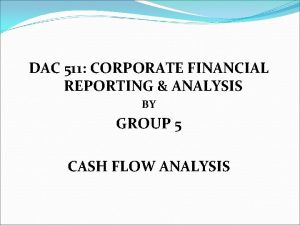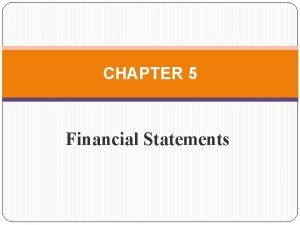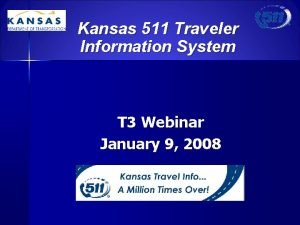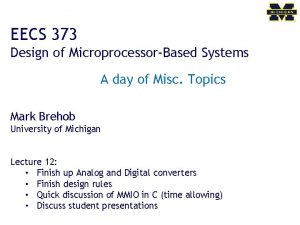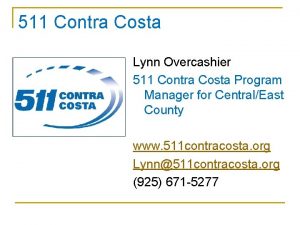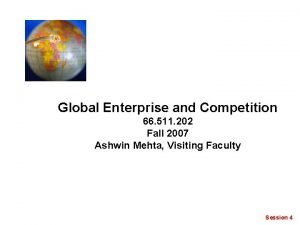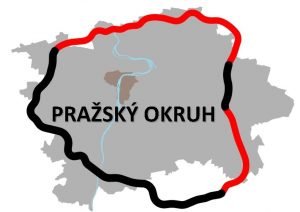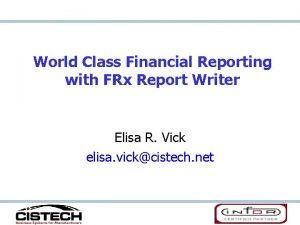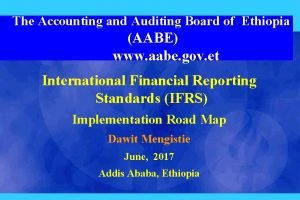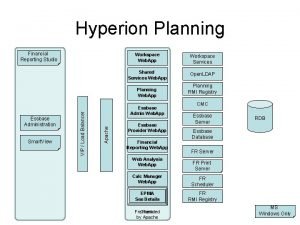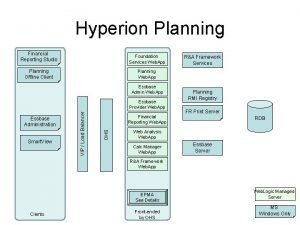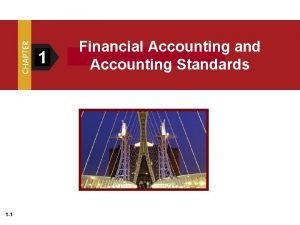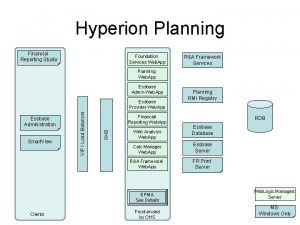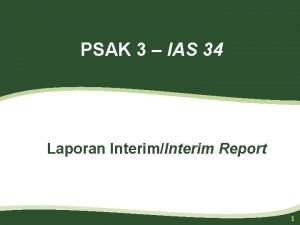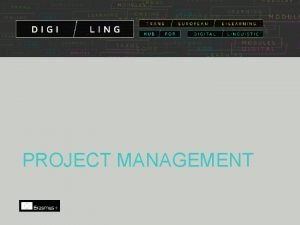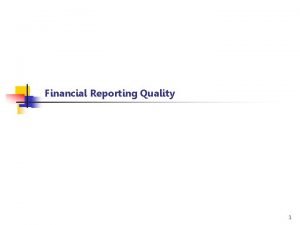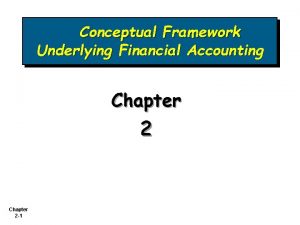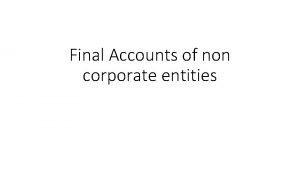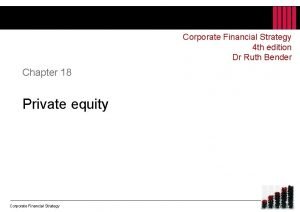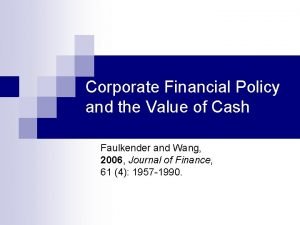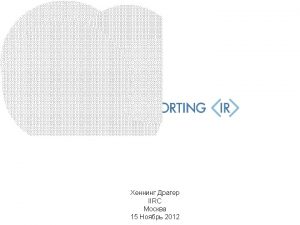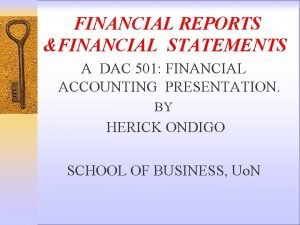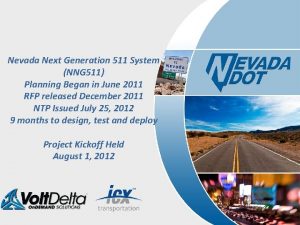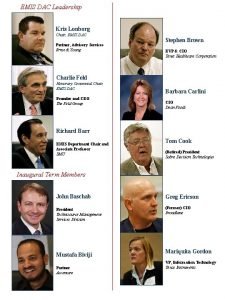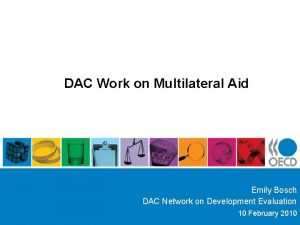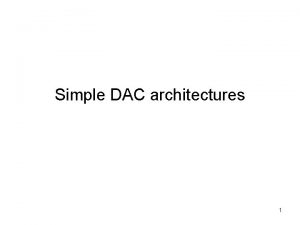DAC 511 CORPORATE FINANCIAL REPORTING ANALYSIS GROUP 7


































- Slides: 34

DAC 511 CORPORATE FINANCIAL REPORTING & ANALYSIS GROUP 7 PRESENTATION Prospective Analysis 1

No. Name Registration Number 1 MERCY CHELANGAT D 63/79059/2012 2 KOSGEI JUSTINE D 63/61383/2013 3 DAVID CHIKEKA D 63/73044/2012 4 ABDIRIZAK MOALIM D 63/60121/2013 5 NYANGALA ALLAN H. D 63/67803/2011 6 FRANK KILONZO M D 63/80470/2012 7 RICHARD NOAH D 63/60864/2013 8 ESBON WAMATHU W. D 63/61264/2013 9 DENNIS KIMANI D 63/60534/2013 10 VERA NYABOKE D 63/61416/2013 2

Prospective Analysis � Prospective analysis is the forecasting of the future financial information. � Two commonly used techniques for prospective analysis are: q Financial Statement forecasting q. Valuation Ø Prospective analysis is central to security valuation where both free cash flow and residual income models require estimates of future financial statements. 3

Continue… � What are prospective financial statements? ◦ Prospective financial statements encompass: q. Financial forecasts and q. Financial projections Ø Two broad stages of financial prospective analysis q Long term forecasting : This involves the analysis of past data and forecasting of financial statements. q Implementation : - This is the use of the forecasts to value common stock or to accomplish any other objective for which the forecast was carried out. 4

Importance of prospective anlaysis q Security valuation: - Residual income model requires estimates of future financial statements q Management and assessment: - viability of companies’ strategic plans. q Assessment of solvency: - company’s debt obligations q Prediction To examine Ability to meet of future performance 5

Compilation of prospective financial statement � Procedure: 1. Inquire of the responsible party as to the underlying assumptions developed. 2. Compile or obtain a list of the underlying assumptions and consider the possibility of obvious omissions or inconsistencies. 3. Verify the mathematical accuracy of the assumptions 4. Read the prospective financial statements in order to identify departures from IAS 1 presentation guidelines 5. Obtain a client representation letter in order to confirm that the responsible party acknowledges its responsibility for the prospective statements 6

Steps in examining prospective financial statements ◦ Step 1: - examine inherent and control risk ◦ Step 2: - consider the sufficiency of internal and external sources of information supporting the underlying assumptions ◦ step 3: - Determine the consistency of the assumptions ◦ Step 4: - Determine the reliability and consistency of the historical financial information used ◦ Step 5: - Evaluate the preparation and presentation of the prospective financial statements ◦ Step 6: - Obtain a client representation letter to confirm that the responsible party acknowledges its responsibility for the presentation of the prospective financial statements and the underlying assumptions. 7

Projecting income statement � Projecting financial statements must begin with projecting the Income Statement � and projecting an Income Statement begins by estimating sales. � The sales estimate can be tested for plausibility in four different contexts : ◦ Past sales trends ◦ Market share implied by the sales estimate ◦ Its relation to planned marketing efforts ◦ Production capacity 8

Projecting income statement � Sales forecasts are a function of: 1) Historical trends 2) Expected level of macroeconomic activity 3) The competitive landscape 4) New versus old store mix (strategic initiatives) 9

Projecting cost of goods sold � Cost of Goods Sold (Co. GS) is all costs which can be directly linked to sales. � Always projected as percentage of sales. � the percentage Co. GS assumption can be affected by a variety of factors, both external and internal to the company. � external factor which increases costs, such as rising raw material prices, will increase the Co. GS percentage, unless these costs increases plus margin can be passed on to customers � production efficiencies may decrease this percentage through lowering costs. 10

Projecting operating expenses � Operating expenses are those expenses which are not directly linked to sales. � Are projected on item by item basis � Projecting Depreciation and Interest expenses ◦ Projecting Depreciation and Interest expense requires a look ahead to the projected balance sheet ◦ Past interest expense will be analyzed as a percentage of past debt balances, and the trend extended into the future. 11

Steps in projecting the income statement 1. Project sales 2. Project cost of goods sold and gross profit margins using historical averages as a percent of sales 3. Project operating expenses using historical averages as a percent of sales 4. Project depreciation expense as an historical average percentage of beginning-of-year depreciable assets 5. Project interest expense as a percent of beginning-of-year interest-bearing debt using existing rates if fixed and projected rates if variable 6. Project tax expense as an average of historical tax expense to pre-tax income 12

EXAMPLE. Target Corporation statement of income Figures in Millions 2005 2004 2003 Sales 46, 839 42, 025 37, 410 Cost of goods sold 31, 445 28, 389 25, 498 Gross profit 15, 394 13, 636 8, 134 Selling, general and administrative expense. 10, 534 9, 379 8, 134 Depreciation and amortization expense 1, 259 1, 098 967 Interest expense 570 556 584 Income before tax 3, 031 2, 603 2, 227 Income tax expense 1, 146 984 851 Income (loss) from extraordinary items and discounted operations 1, 313 190 247 Net income 3, 198 1, 809 1, 623 Outstanding shares 891 912 910 Sales growth 11. 455% 12. 336% Gross profit margin 32. 866 32. 447 Selling, general and administrative expense/Sales 22. 49 22. 318 Depreciation expense/Gross prior-year PP&E 6. 333 5. 245 Interest expense/prior-year long-term debt 5. 173 4. 982 Income tax expense/pretax income 37. 809 37. 803 Selected rations in percent 13

Target Projected Income Statement computation. 1 - Sales: $52, 204 = $46, 839 x 1. 11455 2 - Gross profit: $17, 157 = $52, 204 x 32. 866% 3 - Cost of goods sold: $35, 047 = $52, 204 - $17, 157 4 - Selling, general, and administrative: $11, 741 = $52, 204 x 22. 49% 5 - Selling, general, and administrative: $11, 741 = $52, 204 x 22. 49% $1, 410 =$22, 272 (beginning-period PP&E gross) x 6. 333% 6 - Interest: $493 = $9, 538 (beginning-period interest-bearing debt) x 5. 173% 7 - Income before tax: $3, 513 = $17, 157 - $11, 741 - $1, 410 - $493 8 - Tax expense: $1, 328 = $3, 513 x 37. 809% 9 - Extraordinary and discontinued items: none 10 - Net income: $2, 185 = $3, 513 - $1, 328 14

ABC Projected Income Statement Income statement in millions Forecasting steps 2006 Estimates Total revenues $52, 204 Cost of goods sold 35, 047 Gross profit 17, 157 Selling, general, and administrative expense 11, 741 Depreciation and amortization expense 1, 410 Interest expense 493 Income before tax 3, 513 Income tax expense 1, 328 Income (loss) from extraordinary items and discontinued operations 0 Net income $ 2, 185 Outstanding shares 891 Forecasting Assumptions (in percent) Sales growth 11. 455% Gross profit margin 32. 866 15

Projected balance sheet Steps: 1. Project current assets other than cash, using projected sales or cost of goods sold and appropriate turnover ratios as described below. 2. Project PP&E increases with capital expenditures estimate derived from historical trends or information obtained in the MD&A section of the annual report. 3. Project current liabilities other than debt, using projected sales or cost of goods sold and appropriate turnover ratios as described below 4. Obtain current maturities of long-term debt from the long-term debt footnote. 5. Assume other short-term indebtedness is unchanged from prior year balance unless they have exhibited noticeable trends. 16

ABC CORPORATION BALANCESHEET 17

Projection process 18

ABC CORPORATION BALANCESHEET 19

SENSITIVITY ANALYSIS Ø Vary projection assumptions to find those with the greatest effect on projected profits and cash flows Ø Examine the influential variables closely Ø Prepare expected, optimistic, and pessimistic scenarios to develop a range of possible outcomes 20

Residual Income Valuation Model Ø The residual income valuation model defines equity value at time t as the sum of current book value and the present value of all future expected residual income: � where BVt is book value at the end of period t, RIt + n is residual income in period t + n, and k is cost of capital (see Chapter 1). Residual income at time t is defined as comprehensive net income minus a charge on beginning book value, that is, RIt = NIt - (k x BVt - 1). 21

Application of Prospective Analysis in the Residual Income Valuation Model In its simplest form, we can perform a valuation by projecting the following parameters: -Sales growth. -Net profit margin (Net income/Sales). -Net working capital turnover (Sales/Net WC). -Fixed-asset turnover (Sales/Fixed assets). -Financial leverage (Operating assets/Equity). -Cost of equity capital 22

Advantages of Residual income model 1. Residual income models make use of data readily available from a firm's financial statements and can be used well with firms who do not pay dividends or do not generate positive free cash flow. 2. Residual income models look at the economic profitability of a firm rather than just its accounting profitability. 23

Drawback of using residual Income model � The biggest drawback of the residual income method is the fact that it relies so heavily on forward looking estimates of a firm's financial statements, leaving forecasts vulnerable to psychological biases or historic misrepresentation of a firms financial statements 24

Continue…. � Therefore, the model is useful when; Ø A company does not pay dividends or dividends are not predictable Ø FCF is negative over a comfortable forecast horizon Ø There is great uncertainty in estimating terminal values � Not useful when; 1. There are significant departures from clean surplus accounting. E. g ü Gains on marketable securities are reflected in stockholder’s equity as “comprehensive income” rather than as income on the income statement ü Wide use of employee stock options ü Foreign currency translations 2. Determinants of residual income (e. g. , book value and ROE) are not predictable 25

Trends in Value Drivers The Residual Income valuation model defines residual income as: RIt = NIt – (k X BVt-1) = (ROEt – k) X BVt-1 Where ROE = NI/BVt-1 - Stock price is only impacted so long as ROE ≠ k - Shareholder value is created so long as ROE > k - ROE is a value driver as are its components - Net Profit Margin - Asset Turnover - Financial leverage Two relevant observations: - ROEs tend to revert to a long-run equilibrium. - The reversion is incomplete. 26

Trends in Value Drivers Reversion of ROE 27

Trends in Value Drivers Reversion of Net Profit Margin 28

Trends in value drivers Reversion of Total Asset Turnover 29

PROJECTED CASHFLOW STATEMENT � The statement of cash flows is another financial statement that provides financial information just as the balance sheet and the income statement � The purpose of this statement of cash flows is to provide information on the cash inflows and outflows of a certain business for a period � cash flow statement shows aspects of liquidity of a firm � The Cash Flow Projection shows the cash that is anticipated to be generated over a chosen period of time in the future. 30

IMPORTANCE OF PROJECTIONS OF CASHFLOWS � Uses of projection of cash flows are that it enables us to determine the ◦ Credit worthiness of a company ◦ Loan structuring � All in all the main purpose of preparing a cash flow projection is to determine shortages or excesses in cash from that necessary to operate the business 31

Steps in determining the projection of cash flow 1. Determine the total cash receipts which results from the cash sales, other income(credit accounts) and loans/other cash injections 2. Determine the total cash paid out which results from purchases, wages, Taxes (real estate, etc. ), Supplies (office & operations), repair and maintenance, marketing, advertising, car delivery and travel, accounting and legal charges, rent, telephone and postal charges, utilities among others. 3. Determine noncash operations such as depreciation, gains or losses to assist us in changing from accrual basis to cash basis 32

Continue…. 4. Using the indirect method we determine the net income from the income statement , where we deduct the expenses from the income then we adjust the non cash charges such as depreciation, gains or losses 5. After that we determine the net change in cash from operating, financing and investing activities where operating involve increase(decrease) in assets and liabilities, financing activities say increase(decrease) in long term debt, dividends among others and investing activities resulting from increase(decrease) in capital expenditures 6. Finally add (deduct) the net change in cash from the beginning balance to determine the projected ending balance. 33

THE END THANK YOU 34
 Corporate financial reporting and analysis
Corporate financial reporting and analysis Corporate financial reporting objectives
Corporate financial reporting objectives Royaume de clovis en 511
Royaume de clovis en 511 Kansas 511
Kansas 511 Eecs 373
Eecs 373 511 contra costa
511 contra costa Kev 775
Kev 775 511
511 Goroo trip planner
Goroo trip planner Cse 511
Cse 511 Adw 511
Adw 511 Circulation 511
Circulation 511 Stavba 511
Stavba 511 Sokp 511
Sokp 511 12345
12345 Objective of corporate governance
Objective of corporate governance Frx report manager
Frx report manager Aabe ethiopia
Aabe ethiopia Purpose of financial statements
Purpose of financial statements What is financial reporting studio?
What is financial reporting studio? Financial reporting essbase
Financial reporting essbase Third level of conceptual framework
Third level of conceptual framework American accounting standards
American accounting standards What is financial reporting studio?
What is financial reporting studio? Cbd financial reporting framework
Cbd financial reporting framework Ias 34 interim financial reporting
Ias 34 interim financial reporting Project management financial reporting
Project management financial reporting Limitations of financial reporting
Limitations of financial reporting Chapter 2 conceptual framework for financial reporting
Chapter 2 conceptual framework for financial reporting International financial reporting standards 9
International financial reporting standards 9 Limitations of financial reporting
Limitations of financial reporting Fair value historical cost
Fair value historical cost Financial statements of non corporate entities
Financial statements of non corporate entities Corporate financial strategy
Corporate financial strategy Corporate financial policy and the value of cash
Corporate financial policy and the value of cash
